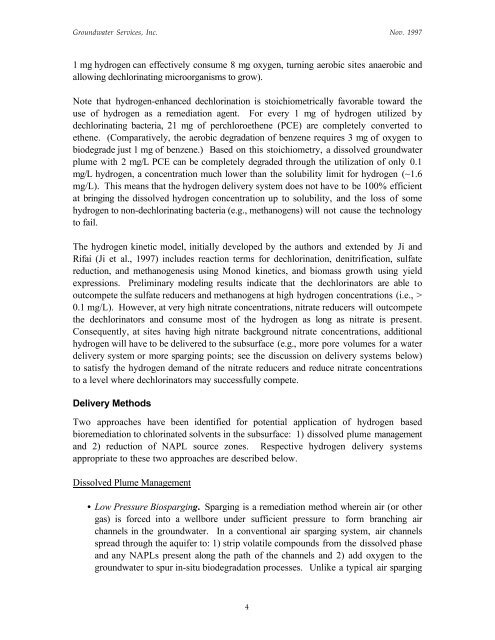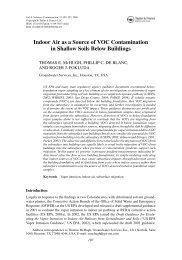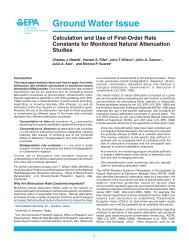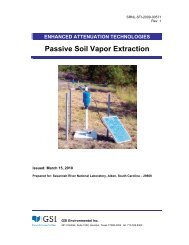direct hydrogen addition for the in-situ biodegradation of chlorinated
direct hydrogen addition for the in-situ biodegradation of chlorinated
direct hydrogen addition for the in-situ biodegradation of chlorinated
You also want an ePaper? Increase the reach of your titles
YUMPU automatically turns print PDFs into web optimized ePapers that Google loves.
Groundwater Services, Inc. Nov. 1997<br />
1 mg <strong>hydrogen</strong> can effectively consume 8 mg oxygen, turn<strong>in</strong>g aerobic sites anaerobic and<br />
allow<strong>in</strong>g dechlor<strong>in</strong>at<strong>in</strong>g microorganisms to grow).<br />
Note that <strong>hydrogen</strong>-enhanced dechlor<strong>in</strong>ation is stoichiometrically favorable toward <strong>the</strong><br />
use <strong>of</strong> <strong>hydrogen</strong> as a remediation agent. For every 1 mg <strong>of</strong> <strong>hydrogen</strong> utilized by<br />
dechlor<strong>in</strong>at<strong>in</strong>g bacteria, 21 mg <strong>of</strong> perchloroe<strong>the</strong>ne (PCE) are completely converted to<br />
e<strong>the</strong>ne. (Comparatively, <strong>the</strong> aerobic degradation <strong>of</strong> benzene requires 3 mg <strong>of</strong> oxygen to<br />
biodegrade just 1 mg <strong>of</strong> benzene.) Based on this stoichiometry, a dissolved groundwater<br />
plume with 2 mg/L PCE can be completely degraded through <strong>the</strong> utilization <strong>of</strong> only 0.1<br />
mg/L <strong>hydrogen</strong>, a concentration much lower than <strong>the</strong> solubility limit <strong>for</strong> <strong>hydrogen</strong> (~1.6<br />
mg/L). This means that <strong>the</strong> <strong>hydrogen</strong> delivery system does not have to be 100% efficient<br />
at br<strong>in</strong>g<strong>in</strong>g <strong>the</strong> dissolved <strong>hydrogen</strong> concentration up to solubility, and <strong>the</strong> loss <strong>of</strong> some<br />
<strong>hydrogen</strong> to non-dechlor<strong>in</strong>at<strong>in</strong>g bacteria (e.g., methanogens) will not cause <strong>the</strong> technology<br />
to fail.<br />
The <strong>hydrogen</strong> k<strong>in</strong>etic model, <strong>in</strong>itially developed by <strong>the</strong> authors and extended by Ji and<br />
Rifai (Ji et al., 1997) <strong>in</strong>cludes reaction terms <strong>for</strong> dechlor<strong>in</strong>ation, denitrification, sulfate<br />
reduction, and methanogenesis us<strong>in</strong>g Monod k<strong>in</strong>etics, and biomass growth us<strong>in</strong>g yield<br />
expressions. Prelim<strong>in</strong>ary model<strong>in</strong>g results <strong>in</strong>dicate that <strong>the</strong> dechlor<strong>in</strong>ators are able to<br />
outcompete <strong>the</strong> sulfate reducers and methanogens at high <strong>hydrogen</strong> concentrations (i.e., ><br />
0.1 mg/L). However, at very high nitrate concentrations, nitrate reducers will outcompete<br />
<strong>the</strong> dechlor<strong>in</strong>ators and consume most <strong>of</strong> <strong>the</strong> <strong>hydrogen</strong> as long as nitrate is present.<br />
Consequently, at sites hav<strong>in</strong>g high nitrate background nitrate concentrations, <strong>addition</strong>al<br />
<strong>hydrogen</strong> will have to be delivered to <strong>the</strong> subsurface (e.g., more pore volumes <strong>for</strong> a water<br />
delivery system or more sparg<strong>in</strong>g po<strong>in</strong>ts; see <strong>the</strong> discussion on delivery systems below)<br />
to satisfy <strong>the</strong> <strong>hydrogen</strong> demand <strong>of</strong> <strong>the</strong> nitrate reducers and reduce nitrate concentrations<br />
to a level where dechlor<strong>in</strong>ators may successfully compete.<br />
Delivery Methods<br />
Two approaches have been identified <strong>for</strong> potential application <strong>of</strong> <strong>hydrogen</strong> based<br />
bioremediation to chlor<strong>in</strong>ated solvents <strong>in</strong> <strong>the</strong> subsurface: 1) dissolved plume management<br />
and 2) reduction <strong>of</strong> NAPL source zones. Respective <strong>hydrogen</strong> delivery systems<br />
appropriate to <strong>the</strong>se two approaches are described below.<br />
Dissolved Plume Management<br />
¥ Low Pressure Biosparg<strong>in</strong>g. Sparg<strong>in</strong>g is a remediation method where<strong>in</strong> air (or o<strong>the</strong>r<br />
gas) is <strong>for</strong>ced <strong>in</strong>to a wellbore under sufficient pressure to <strong>for</strong>m branch<strong>in</strong>g air<br />
channels <strong>in</strong> <strong>the</strong> groundwater. In a conventional air sparg<strong>in</strong>g system, air channels<br />
spread through <strong>the</strong> aquifer to: 1) strip volatile compounds from <strong>the</strong> dissolved phase<br />
and any NAPLs present along <strong>the</strong> path <strong>of</strong> <strong>the</strong> channels and 2) add oxygen to <strong>the</strong><br />
groundwater to spur <strong>in</strong>-<strong>situ</strong> <strong>biodegradation</strong> processes. Unlike a typical air sparg<strong>in</strong>g<br />
4






